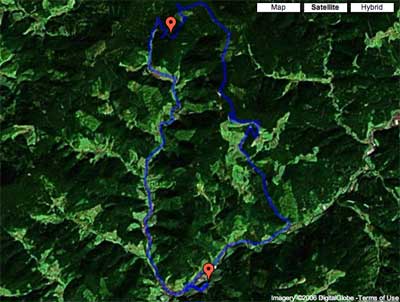Now
that my non-geometry
post is linked via the comments in this
string-coffee-table post which in turn is available through a
trackback from the Kontsevich-Soibelman
paper it is perhaps useful to add a few links.
The little
I’ve learned from reading about Connes-style non-commutative geometry is
this : if you have a situation where a discrete group is acting with a
bad orbit-space (for example, $GL_2(\mathbb{Z})$ acting on the whole
complex-plane, rather than just the upper half plane) you can associate
to this a $C^*$-algebra and study invariants of it and interprete them
as topological information about this bad orbit space. An intruiging
example is the one I mentioned and where the additional noncommutative
points (coming from the orbits on the real axis) seem to contain a lot
of modular information as clarified by work of Manin&Marcolli and
Zagier. Probably the best introduction into Connes-style
non-commutative geometry from this perspective are the Lecture on
Arithmetic Noncommutative Geometry by Matilde Marcolli. To
algebraists : this trick is very similar to looking at the
skew-group algebra $\mathbb{C}[x_1,\ldots,x_n] * G$ if
you want to study the _orbifold_ for a finite group action on affine
space. But as algebraist we have to stick to affine varieties and
polynomials so we can only deal with the case of a finite group,
analysts can be sloppier in their functions, so they can also do
something when the group is infinite.
By the way, the
skew-group algebra idea is also why non-commutative algebraic
geometry enters string-theory via the link with orbifolds. The
easiest (and best understood) example is that of Kleinian singularities.
The best introduction to this idea is via the Representations
of quivers, preprojective algebras and deformations of quotient
singularities notes by Bill Crawley-Boevey.
Artin-style non-commutative geometry aka
non-commutative projective geometry originated from the
work of Artin-Tate-Van den Bergh (in the west) and Odeskii-Feigin (in
the east) to understand Sklyanin algebras associated to elliptic curves
and automorphisms via ‘geometric’ objects such as point- (and
fat-point-) modules, line-modules and the like. An excellent survey
paper on low dimensional non-commutative projective geometry is Non-commutative curves and surfaces by Toby
Stafford and
Michel Van den Bergh. The best introduction is the (also
neverending…) book-project Non-
commutative algebraic geometry by Paul Smith who
maintains a
noncommutative geometry and algebra resource page page (which is
also available from the header).
Non-geometry
started with the seminal paper ‘Algebra extensions and
nonsingularity’, J. Amer. Math. Soc. 8 (1995), 251-289 by Joachim
Cuntz and Daniel Quillen but which is not available online. An
online introduction is Noncommutative smooth
spaces by Kontsevich and Rosenberg. Surely, different people have
different motivations to study non-geometry. I assume Cuntz got
interested because inductive limits of separable algebras are quasi-free
(aka formally smooth aka qurves). Kontsevich and Soibelman want to study
morphisms and deformations of $A_{\infty}$-categories as they explain in
their recent
paper. My own motivation to be interested in non-geometry is the
hope that in the next decades one will discover new exciting connections
between finite groups, algebraic curves and arithmetic groups (monstrous
moonshine being the first, and still not entirely understood,
instance of this). Part of the problem is that these three topics seem
to be quite different, yet by taking group-algebras of finite or
arithmetic groups and coordinate rings of affine smooth curves they all
turn out to be quasi-free algebras, so perhaps non-geometry is the
unifying theory behind these seemingly unrelated topics.

